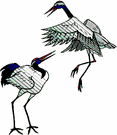RUFF, a rare eurasian visitor in Lincoln County

Today I had a meeting in Rocky Ford and planned to do a little birding afterward. Before leaving Rocky Ford I checked my email to see if there were any interesting birds being seen in the area and saw that there was a "possible" sighting of a juvenile RUFF. Ruff's are very rare shorebirds for which that have been seen only a few times in Colorado. Since this sighting was in Lincoln County only a little over an hour from where I was, I thought it was worth a try so I drove up there.
Fortunately one of birders who had seen the bird was still there, verified that indeed this was a juvenile Ruff and showed it to me. I had never seen this species before but once I saw it with its face and breast in the scope it's buff color made it stand out from the other sandpipers around it. We watched it feed, then groom itself a little and I tried to take photos through the scope. The Ruff is the middle bird in this photo (the Ruff was several hundred feet away and don't have digiscoping equipment so not the best pic). Then it flew off and we couldn't relocate it which was more unfortunate as two more birders came to look for it before I left.
After the other birder left, I stayed and looked for it some more. I finally refound it, but only briefly as a Northern Harrier flushed it with the other shorebirds as it tried to obtain some supper before dark. As the harrier flew repetitively back and forth along the fantastic playa in which this bird was located, the waterfowl and the sandpipers were flushed again and again.
Most of these birds breed in sub-arctic and arctic Europe and Siberia, regularly wandering off their migration course to be seen on both the east and west coasts of the U.S., particularly during fall migration. Apparently there is evidence that they have established a small breeding population in northwestern Alaska.
Another cool bird found in SE Colorado.
SeEtta


























